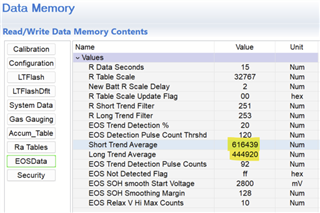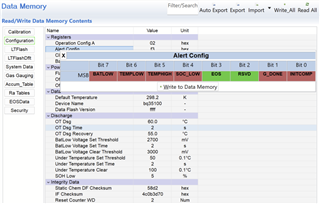Other Parts Discussed in Thread: BQSTUDIO
Tool/software:
I profiled a LTC primary battery (for EOS Mode) until it was dead. The Measured Z rised towards 100% DOD as expected, but the EOS Bit was never set.
Here you can see the final values for the averages:

If I put these values in the formula (from 0.12.1 EOS Mode Fundamentals in SLUA904)
Short Trend Average > Long Trend Average * (1 + EOS Trent Detection/ 100)
This becomes:
616439 > 533904
In SLUA904 it says "Once the equation below is satisfied an EOS condition is set in the Battery Alert register.", so the EOS Bit should have been set.
Here you can see that it is not set:

Can you tell me what could possibly prevent the EOS Bit from being set?
Thanks
Urs




